 Survivalist Communicator 3-3-3 Radio Plan
Survivalist Communicator 3-3-3 Radio Plan
This is the “When, Where, and How” to make radio contact with each other for SHTF. The 333 Radio Plan was designed for SHTF communications. Versions of it are used by survivalist prepper and emergency communications groups. It is based on the easy-to-remember “Survival Rule of Three”. It is often called…

…a Radio Schedule, or a SKED. It is like the communications equivalent of a Rally Point or Disaster Meet-Up Plan.
ABOUT THE 3-3-3 RADIO PLAN
Here’s how the 3-3-3 Radio Plan works:
Turn on your radio. Every 3 hours. For at least 3 minutes. Channel 3.
WHEN: EVERY 3 HOURS
Always use your Local Time for local area communications with the 3-3-3 Radio Plan. At the “top of the hour”, each 3 hours:
Noon, 3pm, 6pm, 9pm.
Midnight, 3am, 6am, 9am.
HOW LONG: AT LEAST 3 MINUTES
At the top of every 3rd hour, turn on your radio. Even if you don’t need to make a call yourself, always turn on your radio and listen for calls for at least 3 minutes. If you have sufficient battery power, or if you have not connected up for a while, then you should listen for 15 minutes. You never know if someone may be trying to reach you, or may need help. If you need to check in, make a short transmission at this time. Say “This is me, just checking in.”
ACCURATE TIME KEEPING
Synchronize your watch with other radio operators whenever possible. If you doubt your watch accuracy, compensate by keeping your radio turned on for a longer duration, before and after every 3rd hour. If you don’t have a watch, try listening to an AM broadcast radio station, they always identify their call letters at the top of each hour.
WHERE: CHANNEL 3
Channel 3 is CB-3, FRS-3, or MURS-3.
CB, FRS, and MURS are the most common types of radios used by survivalists and preppers.
If your organized group has a different designated SHTF channel or Prepper SHTF HAM frequency, you should use it as your 3-3-3 channel. For example: 146.520 FM Simplex, Freenet 3, or PMR466-CH3.
FEATURES OF THE 3-3-3 RADIO PLAN
1. Easy for everyone to remember the “Rule of Three”.
2. Conserves precious battery life for walkie talkies.
3. Gets everyone on the air at the same time.
4. Sets a schedule of 8 times per day to call each other.
5. Avoids impractical hourly schedules that can be a burden in real-life scenarios.
6. Enables the use of short transmissions for optimum success and security.
7. Three hours between contacts is enough time to rest in a survival situation.
8. A person can walk 8 miles in 3 hours, the practical distance limit of handheld radios over average terrain.
9. 3-3-3 is fully interoperable and compatible with the alternative 3-2-1 plan.
HAM RADIO 3-3-3 RADIO PLAN
Ham radios don’t have channel numbers. They have frequencies instead. A channel is really just a specific frequency that has a purpose.
Most hams use 146.520 MHz FM Simplex (No PL) as their 3-3-3 channel.
Some organized Prepper Ham groups use 146.420 FM Simplex.
Non-aligned Survivalist Hams use 146.550 Simplex as the Bug Out Channel (BOC) and 3-3-3.
The most commonly used local ham frequency could become a 3-3-3 channel for your area. But it probably should not be a repeater channel, because repeaters may cease to function when SHTF! Instead, hams could use Simplex FM on the output frequency of the repeater.
Feel free to copy, print, and distribute the 3-3-3 Radio Plan for your fellow preppers and survivalists.
The 3-3-3 Survival Rule is a well known principle in survivalist training. It commits fundamental skills or procedures to memory. The 3-3-3 Radio Plan builds upon the Survival Rule of 3, otherwise known as the Rule of Threes.
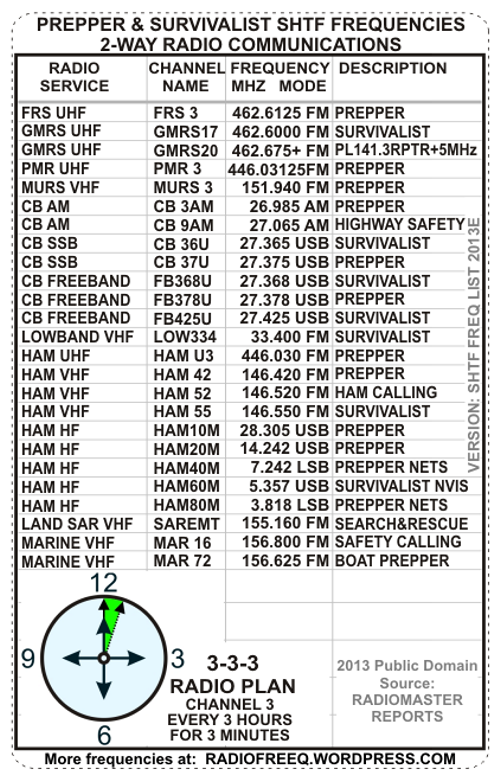
CLICK TO PRINT WALLET SIZE – SHTF FREQUENCY LIST
Prepper Survivalist Channel Frequencies Basic Chart
VHF UHF HF CB MARINE HAM FRS GMRS PMR MURS FM SSB AM
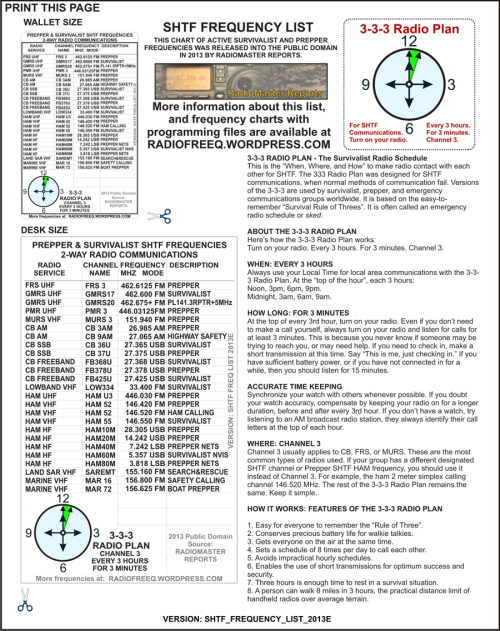
Alternative Radio Schedule Plans
The CH-3 Project 3-2-1 Plan
There is another new proposed alternative format going around among the prepper community called the 321 Plan or 3-2-1 Plan as part of a CH3 Project. The good news, is that the proposed 3-2-1 plan is fully compatible with the good old standard 3-3-3 Radio Plan.
The proposed 3-2-1 Plan advocates an hourly schedule at the top of every hour! An hourly schedule is a fine ambitious plan in concept. It even looks pretty on paper, and it has a catchy name. It was proposed by well-meaning ham radio operators, bless their hearts.
However, speaking from the voice of experience: No one who has ever been forced to keep an hourly schedule on the radio for days or weeks would ever advocate an hourly radio schedule. Especially if they had other responsibilities in life, such as eating, sleeping, working, or take care of family; much less existing in SHTF survival situations.
Challenge: Just try keeping an hourly schedule yourself for a whole day (24 times) and post a reply in the comment section here about it 🙂
Some argue that in an emergency situation, you wouldn’t want to wait more than an hour to reach someone. But, that argument fails to address the real point. No such radio plan should ever be considered the grid-down equivalent of calling 911. Those who want local radio comms among non-professional users to take the place of a professional emergency services call center, should really re-think their entire SHTF plan, because it is totally unrealistic. Don’t plan your preps on everyone listening and calling for you on your radio every hour, 24 times a day; it simply won’t happen, even with the best of intentions.
The proposed hourly 3-2-1 schedule would eat up an HT radio battery within the first few days of SHTF. Compare that to 2 weeks of HT battery life using the 3-3-3 Radio Plan. That gives you some time to re-group and set up alternative resources. Unless you have a constant source of battery recharge power during SHTF, you won’t want to use up your precious battery with frivolous transmissions 24 times a day. And, if you do have a constant source of power during SHTF, you might as well just leave your radio on all the time!
The Sun-Based Radio Plan
What happens to the 3-3-3 Radio Plan if you or your contacts have lost track of the time of day due to watch or clock failure? One traditional alternative from HF commo circles is called the Sun-Based Radio Plan, and it uses a 3-times daily sunrise-noon-sunset schedule.
The sun is the timekeeper. Each contact interval is a window of approximately an hour long, by your best estimation.
Sunrise: The contact interval for sunrise starts slightly before the sun peeks above the horizon, and continues to your best estimate of 1 hour after it has risen completely.
Noon: The contact interval for local sun noon starts when it is observed that the sun is highest in the sky. A small stick stuck in the ground straight up will have the shortest shadow at this time of day. It continues to your best estimate of 1 hour long.
Sunset: The contact interval for sunset starts just before the sun starts to set and continues to your best estimate of 1 hour after it has set completely.
Optional Night: An additional late-night schedule contact interval may be added, and this is normally estimated to about an hour or two hours after sunset. It may also be determined by the position of a specific star constellation, which is agreed upon in advance or by a radio message.
If you are in a valley, a forest, or mountainous terrain, you must compensate and estimate your best guess of the actual sunrise and sunset. During inclement weather, the sun position is estimated, normally by observation of the color of the light. The Sun-Based Radio Plan is not effective at very high latitudes, such as above the Arctic Circle or in Antarctica.
The Sun-Based Radio Plan is especially useful for HF (High Frequency) communications because it takes advantage of the natural daily changes in ionospheric reflection of radio waves. NVIS Near Vertical Incidence Skywave HF propagation peaks for certain frequencies at sunrise and sunset. It also is convenient for communication while traveling or camping, because the scheduled contacts at sunrise and sunset are normal in-camp times.
The original source of this article is the RadioMaster Reports site.

Disclaimer: Content provided in RadioMaster Reports is included for the sole purpose of providing educational information on a passive basis. This information may be useful to the public in the event of emergencies or disaster recovery, especially when normal techniques are not an available option. Users of this educational information are solely responsible for their actions.
©2013 RadioMaster Reports



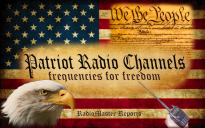

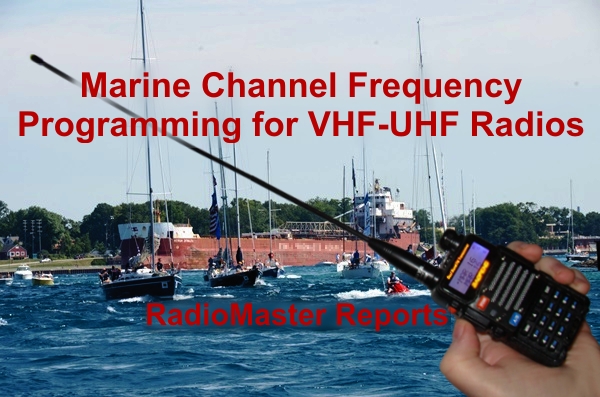

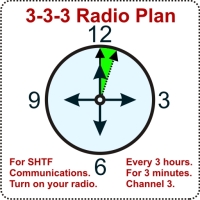

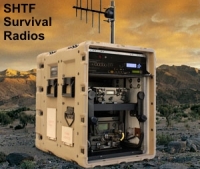
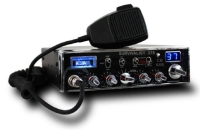
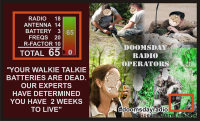


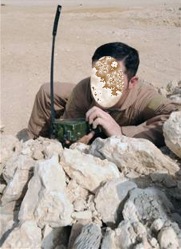


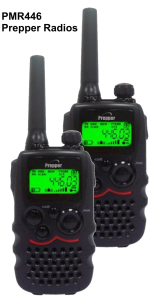

“Sun-Based Radio Plan” was updated -RadioMaster
Makes sense.
Awesome idea. Thanks I will pass this along to my group.
Reblogged this on arthemis300.
Like a rally point, but on the radio. Cool.
Sorry, but what specific channel is supposed to be programed into ‘Channel 3’?
CHANNEL 3
Channel 3 usually applies to CB channel 3, FRS channel 3, or MURS channel 3. These are the most common types of radios used by preppers. If your group has a different designated SHTF channel or Prepper SHTF HAM frequency, you should use it instead of Channel 3. The rest of the 3-3-3 Radio Plan remains the same. Keep it simple.
Before SHTF, this concept could possibly be expanded in order to find other like-minded people in your immediate area. On the 3rd of the month, at one of the specified times, call on a frequency you are able to. Perhaps you’ll be able to strengthen your position by making some new local contacts!
Reblogged this on Des Moines Preppers Network .
All groups need to start practicing this now to get more people involved, to know who is in your area, we are almost to the SHTF EVENT!
Reblogged this in German on egimoto.com
The establishment of CB 3AM was not deliberate as this channel cannot be used in AM mode in most countries. But if phone and notebook are only available for a short time and Fonie requires personal permanent presence, then it quickly becomes clear that only packet radio with Autobattarie and Raspberry PI makes sense in the long term, because you only need to switch on a low-power 12V DVD monitor to call up messages – the TNC does the rest by itself. I’m currently working on porting the basic functions of Eskay Packet Version 9.75 to the Raspberry. RIP Sigi Kluger
im not going to say that only hams know about this but since we are in the begining of a solar minimum the sun rise /set comms will work the best its a propagation mode know as grey line propagation basicly just before and just after sunset you wil get enhanced propagation allmost any where in the grey line on planet earth that line can be as wide as the west coast to the east coast of the lower 48 on a good day so maybe you guys aught to factor in the grey line to you 3-3-3 sked kuz the time changes with the season but grey line happens twice a day 365 a year….maybe folks should do a print out of the official sunrise/set to capatilize on this propagation mode………………………..
kc9mob
ray jones
Can you explain why you prefer local time to UTC for a 3-3-3 radio plan?
@Luc Think of your comms as local comms.